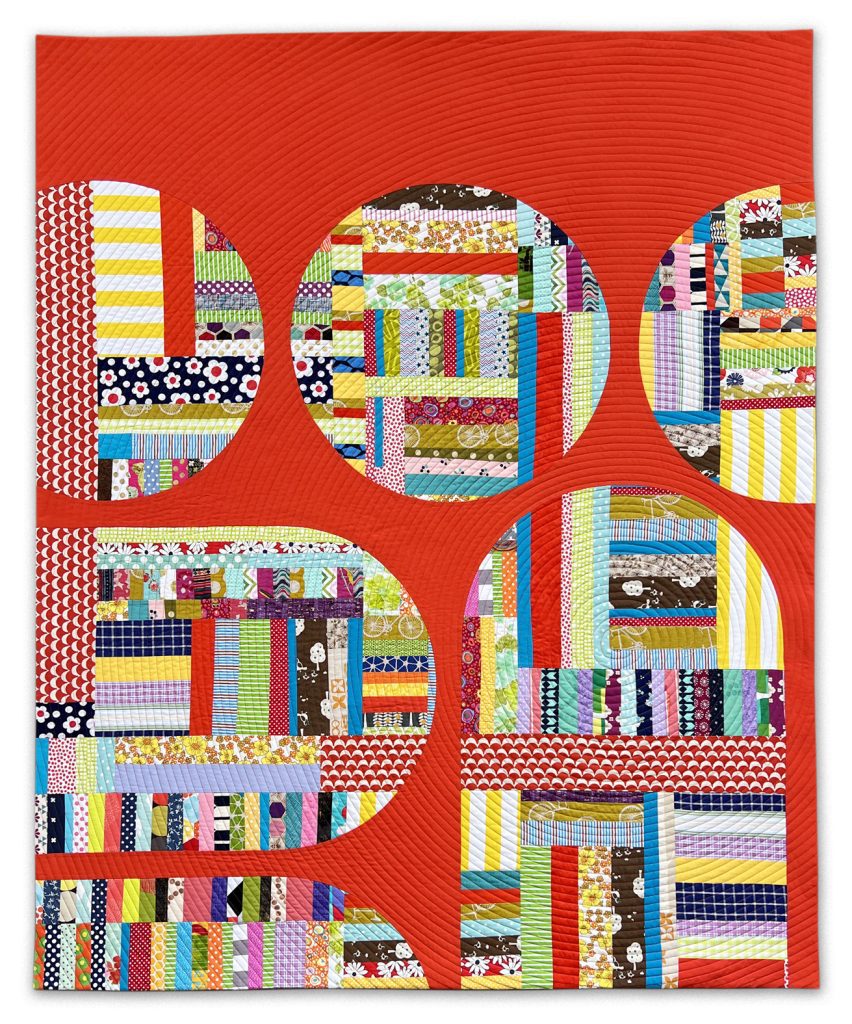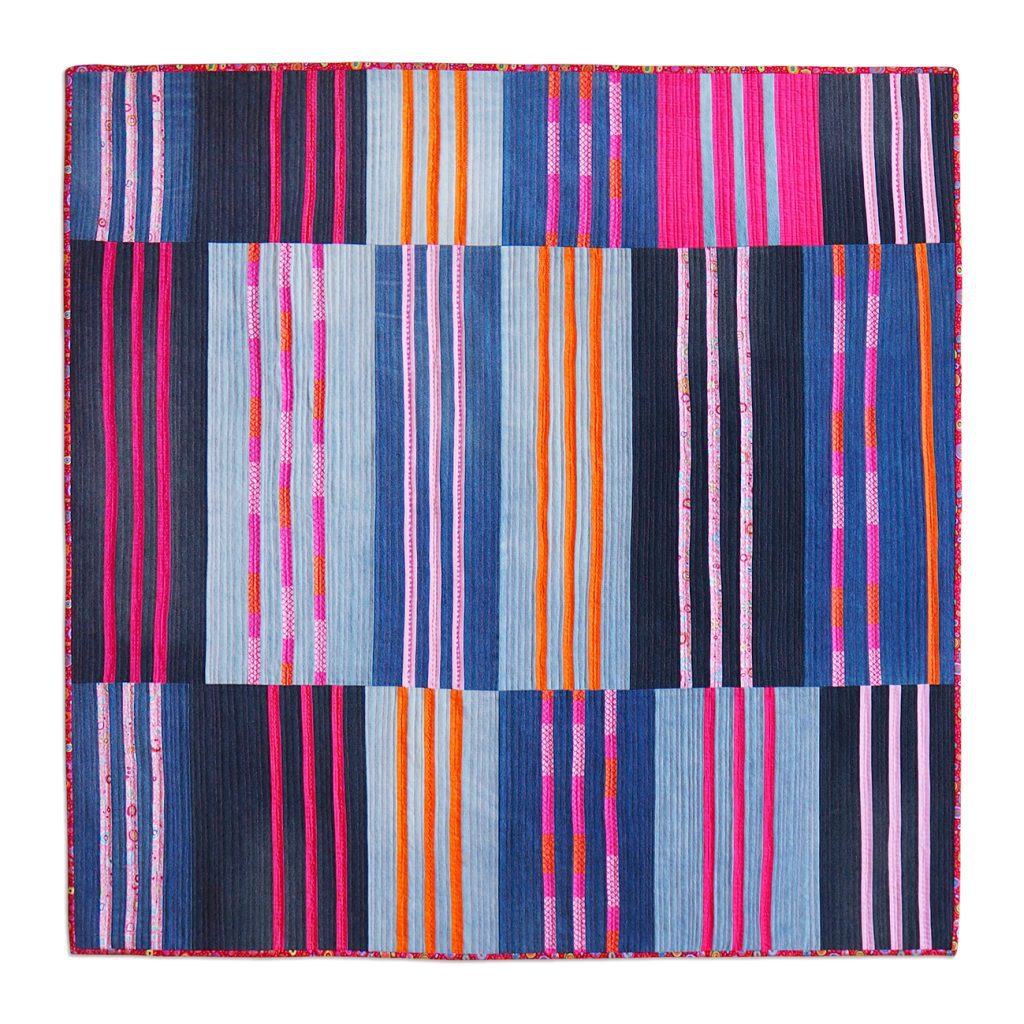Meet the Maker: Tara Glastonbury, Quilt Artist at Stitch & Yarn

Tara Glastonbury is a modern quilter with a penchant for bright colours, recycled materials and bold geometry. This year at MPavilion 10, Tara is bringing her signature style to the MPavilion Quilt Challenge, a creative collaboration between Studio Ongarato and the Melbourne Modern Quilters Guild.
We spent some time with Tara to learn more about her practice and design philosophy.
Tell us about how you began your career as a textile artist and designer.
I was taught to knit when I was about five by my Mum and Nana and have been involved with textile crafts ever since. I started a degree in Graphic Design out of school and have been running design studios for way too many years to count. The serious immersion in textiles didn’t start until about 2014 when I studied a part time Cert IV in textile design through RMIT.
What is it about quilting specifically that draws you in?
The mix of utility and art form – a creative canvas with a practical purpose.
‘Test Pattern’ is one of the 16 quilts made by Melbourne Modern Quilt Guild members as a collaboration with MPavilion 10. Both Tara’s challenge quilts were quilted by Sarah Streifeneder.
Your practice is firmly rooted in a love of upcycling. What is your definition of upcycling, and how has it informed your practice and design philosophy?
Upcycling, in terms of my quilts, means using fabrics, worn clothes, sheets etc that have had a previous life – gifted to me, or bought second hand, from a collector or through estate sales. It means using as many of my scraps as I can and then sending anything unusable to a textile recycler.
When I’m not using upcycled textiles I mostly use perennial ones, for example solid colours that will always be around, rather than fabric ranges that are released like fast fashion.
‘Laid Back’ is one of Tara’s pattern quilts featuring one of her favourite upcycled textiles – denim.
What does your average workday look like?
Making a primary household income as a quilt artist and designer doesn’t really happen – most professional quilters derive their income from teaching and it’s more often a secondary household income – so I still juggle contract work around it.
If I’m not contracting, I normally do my computer work in the morning – answering emails, working on upcoming patterns, designing etc. This is more about having access to my coffee machine than anything! Then I head to my studio about 11am and stay there until early evening.
Routines are not really my thing though, so that changes depending on my mood, the season and what else is happening in my life.
What is something that you do every day?
Drink coffee. I can’t live without it.
Where do you look for inspiration?
Spending time looking at other artist’s work is always inspirational – and I don’t mean through social media, although that happens too. Seeing exhibitions in real life, no matter what the medium – always gives me the spark of an idea.
I’m also hugely inspired when I spend time talking with other textile artists, particularly quilt artists. Quilts are not well recognised as an art form in Australia, so having the support of others is important for wellbeing – the Modern Quilt Guild certainly plays a role in that for me, as does having a space at River Studios in West Melbourne.
How would you describe your style? How has it evolved over the years?
Bold, distinctive, with a sure sense of colour, strong geometry and often the use of exaggerated scale.
My quilts tend to fall into one of two categories – those I would show in galleries and work I design for patterns. My exhibition work tends to be more improvisational and less structured.
The pandemic gave me the opportunity to spend a year working almost exclusively on my textiles, so there’s a greater confidence in my work since then.
 ‘Multifarious me’ – currently in the US. Juried as part of the world’s largest modern quilt show.
‘Multifarious me’ – currently in the US. Juried as part of the world’s largest modern quilt show.
What is a philosophy that you live and work by?
“Growth is one of the stupidest purposes ever invented by any culture.
We’ve got to have enough.
Always ask: growth of what, and why, and for whom, and who pays the cost, and how long can it last, and what’s the cost to the planet, and how much is enough?”
– Donella Meadows
What excites you about this year’s MPavilion, designed by Osaka-based architect Tadao Ando? How do you see your quilts (and those created by your peers at the Melbourne Modern Quilt Guild) complementing Ando’s space?
As objects external to the space, I see the quilts as signalling to the visitor that their focus and perception should change, preparing them for the experience of stepping inside.
They bring people into the moment through surprise and delight, before moving into a space of contemplation and the opportunity to view a familiar landscape in a new way.
Being in the pavilion feels like being given the gift of time. A slowing down amidst the pressure to always be doing more.
And finally, what has been the best thing you’ve read, listened to, or watched recently?
My favourite book from last year was This is Happiness by Niall Williams. A beautiful antidote to our times.
—
Enjoy a Tara’s quilts this summer at MPavilion 10, open until 28 March 2024. You can also follow her on Instagram or visit her website to keep up to date with her latest projects.
MPavilion Quilt Challenge

